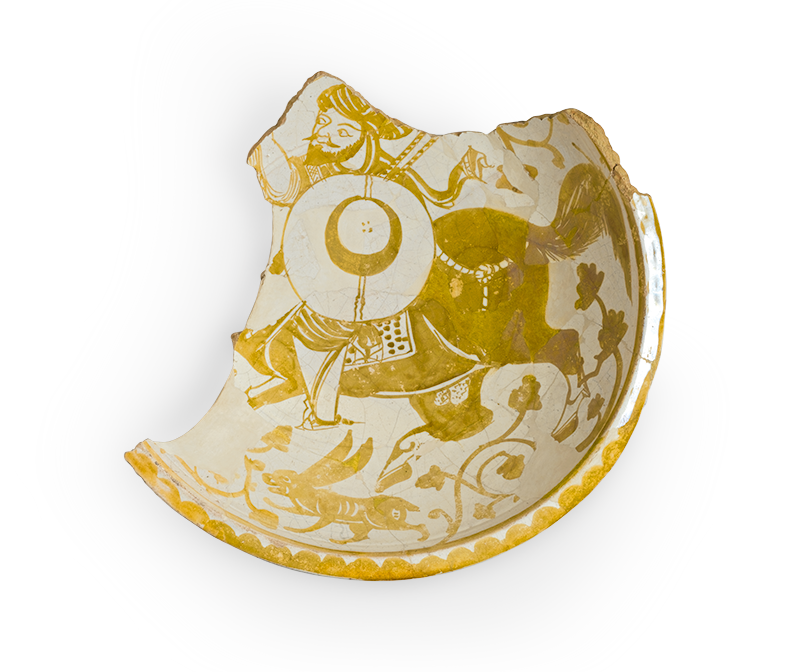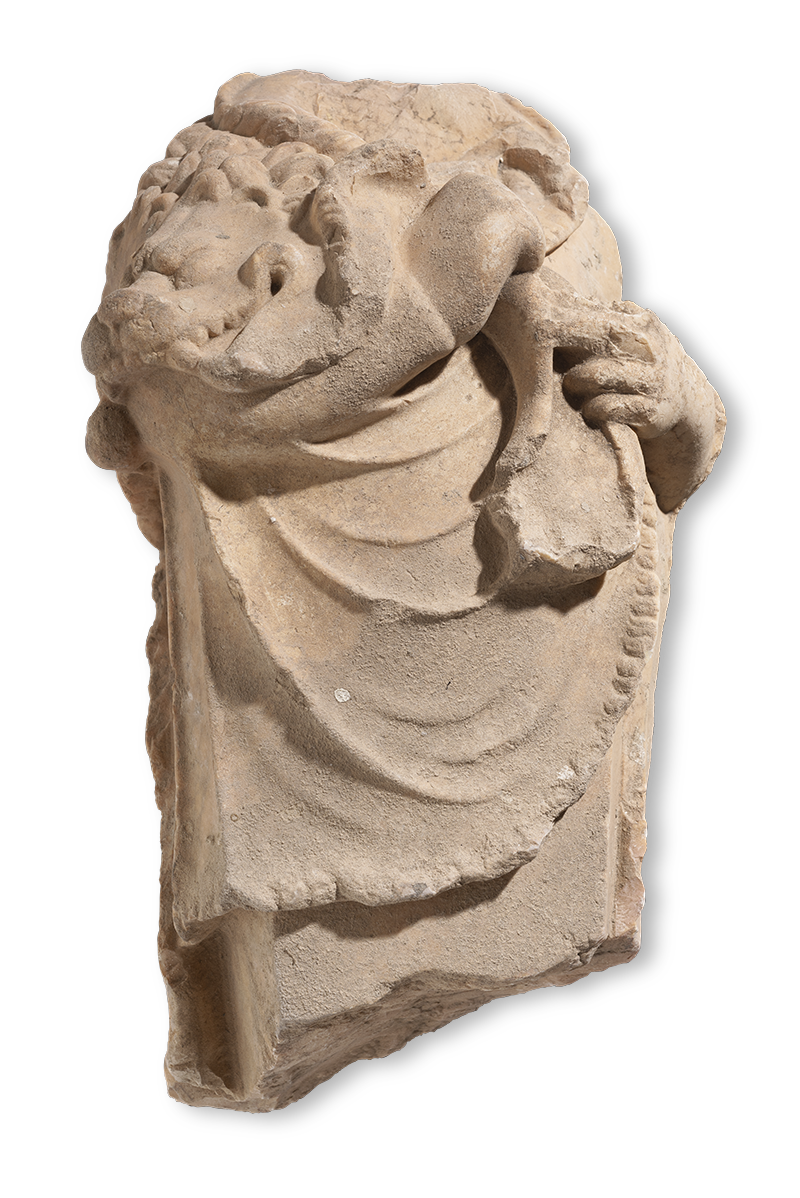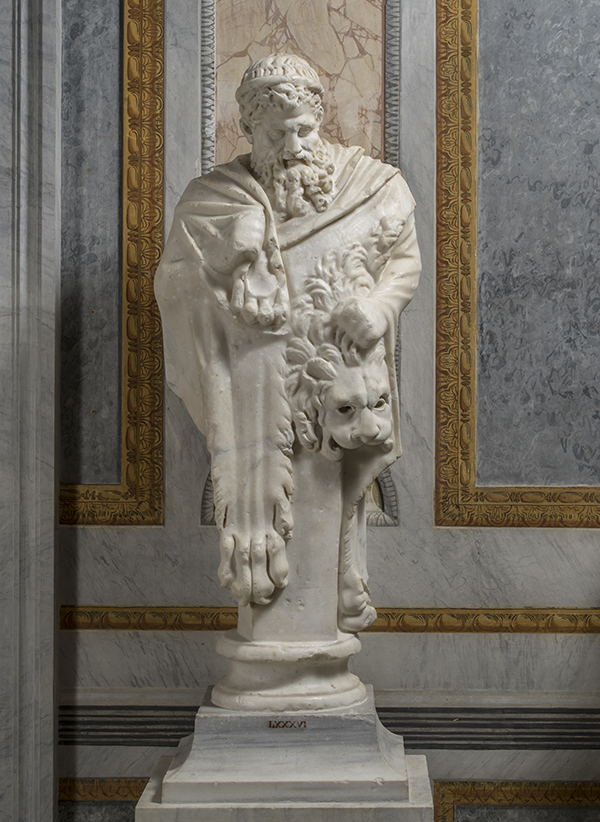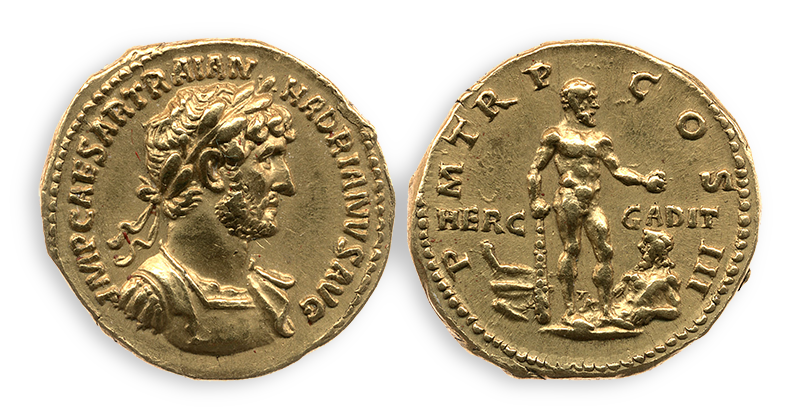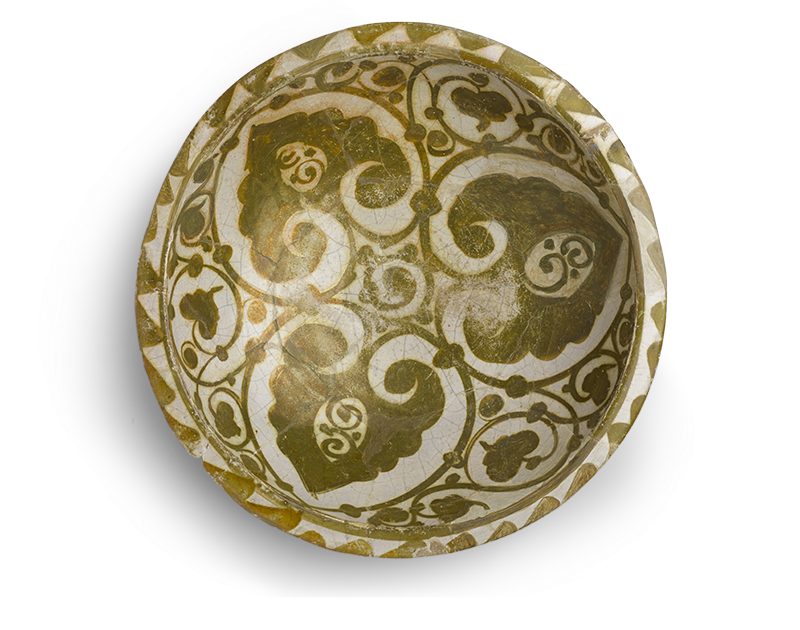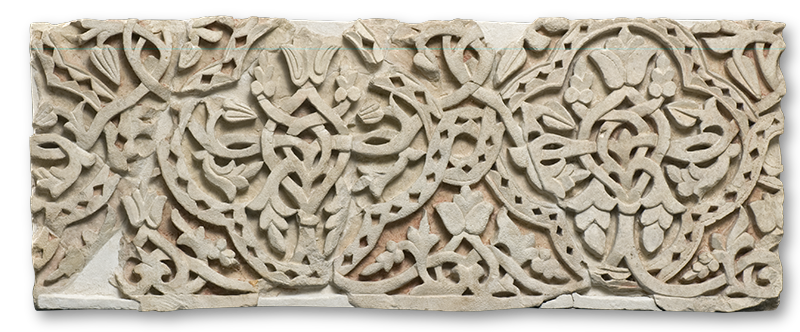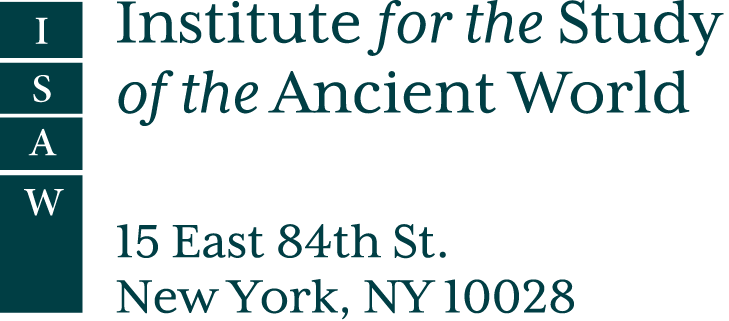Influences and Rivalries
In the tenth century CE, the Umayyads of al-Andalus competed with the Abbasid and Fatimid caliphs for recognition as the legitimate caliphate, the rightful political successors to the Prophet Muhammad, and the sole rulers of the umma, or Muslim community. The ancestors of the Umayyads of al-Andalus had founded a dynasty just a few decades after the Prophetʼs death in 632 CE (10 AH) and ruled over the huge empire created after the early Arab conquests in Western Asia and North Africa. Under their command, this empire had extended in Central Asia and the Iberian Peninsula in 711 CE (92 AH). The rival family of the Abbasids, who descended from Muhammad’s uncle Abbas, toppled the Umayyads to claim the caliphate in 750 CE (132 AH). Finally, the Fatimids, claiming direct descent from the Prophetʼs cousin and son-in-law Ali (b. Abi Talib), took control of North Africa in 909 CE (296 AH), staking their claim as the first Shiite caliphate.
It was against this political landscape that ‘Abd al-Rahman III, the Umayyad emir of Córdoba whose ancestor ‘Abd al-Rahman I had fled to al-Andalus after the Abbasid Revolution, proclaimed himself caliph, taking the title of his predecessors and claiming to be the legitimate ruler of the Islamic world. The Umayyads portrayed the Abbasids as a failed and declining dynasty and viewed the Fatimids as adhering to a heretical interpretation of Islam.
Although political and ideological rivalries played out in the art, architecture, and coinage of the three dynasties, the existence of a single cultural area in the dar al-islam (the Islamic world) eased the adoption of styles, motifs, and artistic patterns that, despite their diversity, referred to a common cultural framework.
The Umayyads also bolstered their legitimacy by claiming the intellectual and artistic achievements of the pre-Islamic past, especially Greco-Roman and Persian antiquity, as a powerful signifier of precedence and authority in the tenth century. Scholars translated Greek, Roman, and Persian texts and appropriated them in a way that was compatible with the Islamic tradition. In doing so, they crafted a narrative of the Iberian Peninsula as a cradle of civilization from which the Umayyad caliphate rose triumphantly. Madinat al-Zahra played host to a revival in classical knowledge, where Islamic scholars saw themselves as heirs to ancient philosophies and sciences, and the caliphs adopted the visual legacy of the Greco-Roman past by incorporating spolia (repurposed objects) into the nascent city and transforming centuries-old iconographic motifs into new symbols of authority.
A Herculanean Legacy
Latin texts were used by Umayyad chroniclers as a source for writing a history of al-Andalus that described a succession of legendary figures and historical rulers that culminated in the rule of the caliphs. The Greek hero Hercules—seen in this herm (a sculpture of a head and torso above a plain, square lower section) found at Madinat al-Zahra—had a deeply rooted association with Iberia that was appropriated by the Umayyads. In Greek mythology, Hercules completed his tenth labor (obtaining the cattle of the giant Geryon) in the Iberian Peninsula and, en route back east, founded the cities of Seville and Cádiz, where there was a significant temple dedicated to him. The Strait of Gibraltar marked the westernmost point of his travels, with its promontories known as the “pillars of Hercules.” This landmark was considered the limit of imperial rule by Roman and Byzantine authors.
Dynastic predecessors to the Umayyads in Iberia had already cultivated an association with Hercules to strengthen their legitimacy, notably through coinage. They included the Barcids from Carthage (the most famous of whom was the general Hannibal) and the Roman emperors Trajan and Hadrian, both of whom were born in present-day Andalusia (Roman “Hispania Baetica”). It is tempting to link the placement of this sculpture in Madinat al-Zahra to this tradition, establishing a line of relation between ancient mythology and the Umayyad city.
Left: Aureus with bust of Hadrian (obverse). Right: Hercules standing, resting arm on club (reverse), gold, 119–123 CE, British Museum, 658151001. © The Trustees of the British Museum.
The Influence of the Abbasids
While the Abbasids were fierce rivals of the Umayyads, they were also a source of inspiration for court culture in al-Andalus. Umayyad tableware was influenced both by technological changes from China in the form of white glazed ceramics and by the golden lustrewares developed by the Abbasids, such as this fragment of a bowl with a mounted warrior. These innovations drastically changed fashions in luxury pottery across the medieval world. The Abbasid capital of Samarra (838–892 CE/223–278 AH), while short-lived, was also enormously influential in the decoration of palaces and mosques across the Islamic caliphates. At Madinat al-Zahra, carved wall reliefs with flowing and complex vegetal designs like the one on the relief above took indirect inspiration from the carved stucco wall reliefs found in the Abbasid capital. Andalusi artisans drew increasingly complex geometric and vegetal (stalks shoots, stems, foliage, fruits, or stylized leaves) traditionally known as “arabesques.” They also took advantage of the angularities of the early Arab script and calligraphy to transform writing into meaningful ornamental elements. In this case, the relief was carved from more prestigious marble and white limestone rather than stucco, as a form of one-upmanship over the Umayyads’ Abbasid competitors.
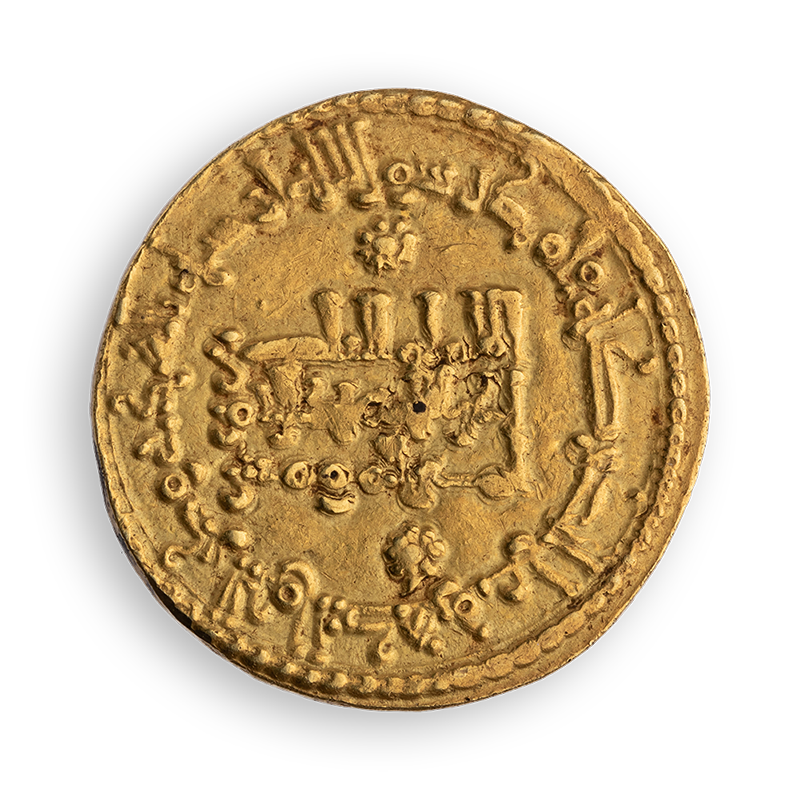
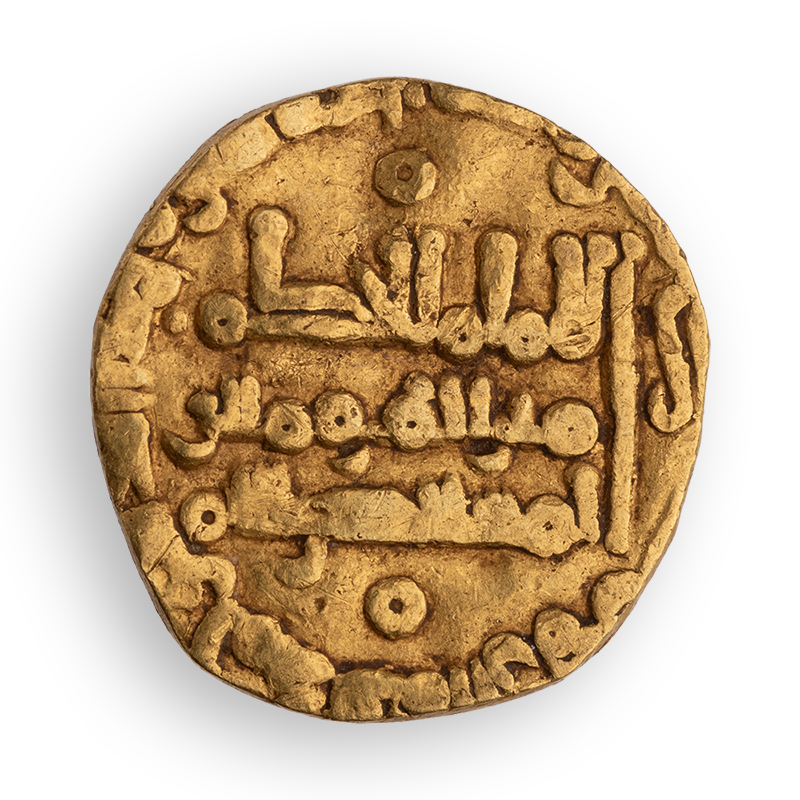
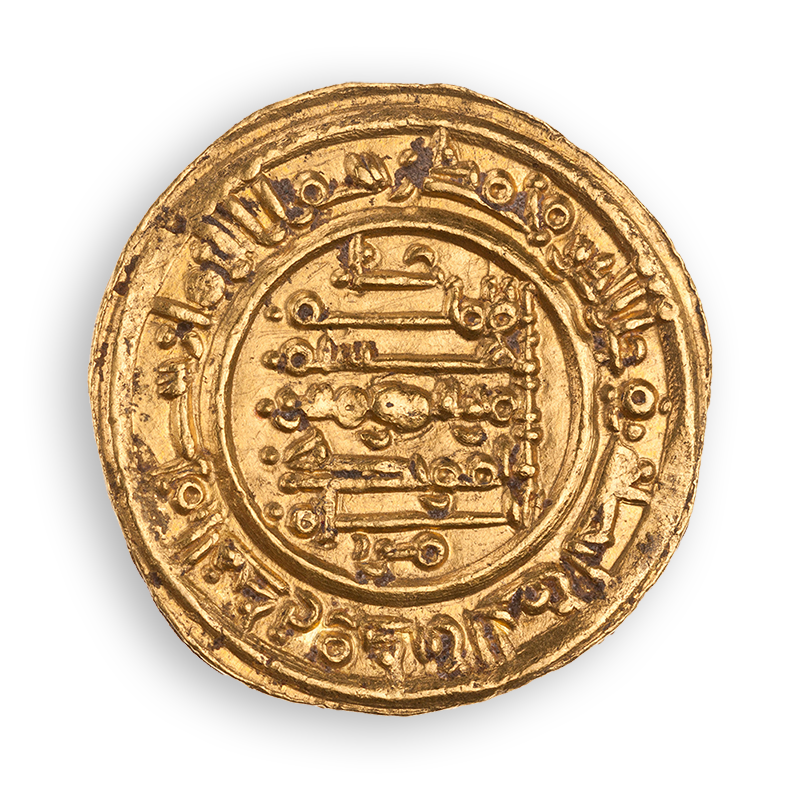
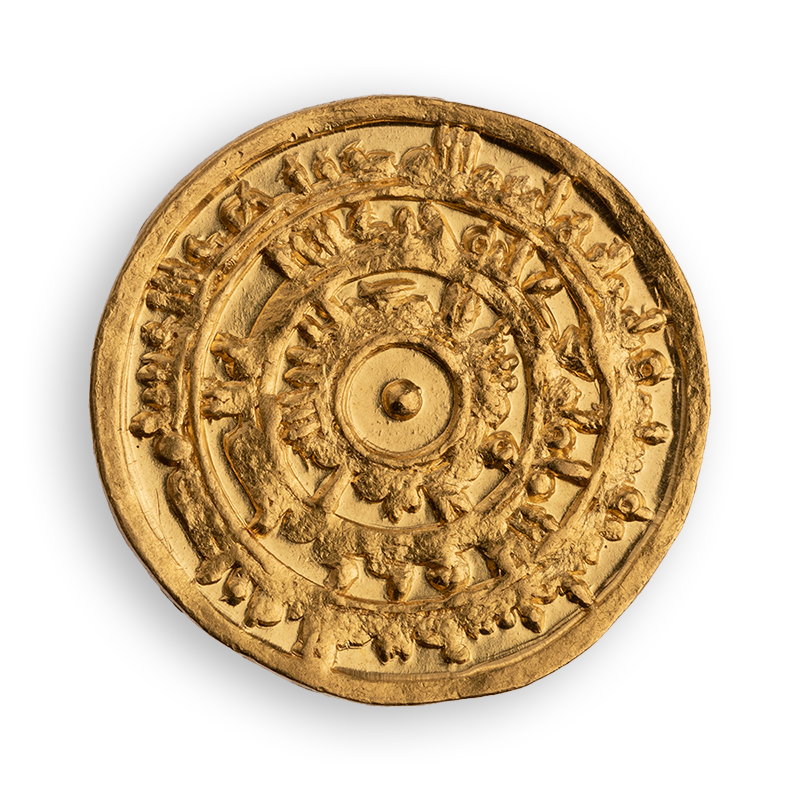
Islamic Coins from al-Andalus
Gold coin production in al-Andalus had paused for nearly two centuries before the accession of the first Umayyad ruler, ‘Abd al-Rahman I (756–788 CE/138–171 AH). Gold dinars were not issued again until ca. 929 CE (316 AH), when ‘Abd al-Rahman III (912–961 CE/299–349 AH) proclaimed himself caliph. A few years later, the recently inaugurated mint at Madinat al-Zahra began producing gold and silver coinage for the new state. From that point until the end of Umayyad rule in al-Andalus, each caliph’s name and titles, the name of the mint, and the year of issue were inscribed on the reverse of a coin. The production of silver coinage by the Umayyad caliphs was massive, with one million coins issued in some years. The production of dinars was more erratic as it depended on the irregular supply of gold from Africa’s interior.
As they were competing with the Abbasids and Fatimids to claim the caliphate, the Umayyads used their coinage to express their authority and reinforce their claims to power. While by this period it was standard for Islamic coinage to be primarily epigraphic, the typological reform and gradual introduction of a variety of vegetal, floral, and geometric motifs on these Andalusian Umayyad coins set them apart from other Islamic coins of the time.
